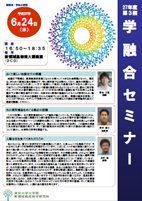AY2015 3rd Gakuyugo Seminar
- Date&Time:
- Jun 24, 2015 16:50~18:35
- Venue:
- Large Lecture Room (2C0), New Frontier Science Bldg.

Old and New Subsidence Problems
Lecturer Masaatsu AichiThe problem of land subsidence became a major social issue during the period of rapid economic growth, as one of the four major types of pollution. Today, under extremely strict pumping regulations, the problem has subsided, especially in urban areas, and is often perceived as a problem of the past. On the other hand, there have been cases of damage to underground infrastructure due to the resulting rapid rise in groundwater levels. Looking outside Japan, land subsidence pollution due to excessive groundwater use is currently underway, mainly in major cities in Asia, and is expected to follow the same course as in Japan in the future. How can we apply Japan's experience as an advanced country to solve the problem in these regions? I would like to discuss the prospects, including recent research trends in modeling and monitoring technologies.

Recent Topics on the Local Structure of Water
Associate Professor Yoshihisa Harada
In the last decade, there has been a controversy over the local structure of water. It all started with the observation of the electronic state of water by soft X-ray absorption spectroscopy, published in Science in 2004. This fundamental question, whether water is homogeneous or inhomogeneous, has been answered in a completely different way by X-ray spectroscopy with the knowledge of electronic structure. In this talk, I will introduce the world of synchrotron radiation, the way to understand the structure of liquid that underlies this controversy, and our recent efforts using soft X-ray emission spectroscopy, and look forward to the future of water research.

What have humans been eating?
Professor Minoru YonedaWe humans are very unique animals in that we are upright bipedal primates, but we also have many other biological characteristics. We often take it for granted that we are different from other animals, but this is due to the 7 million years of human evolution. What characteristics do we have, and how and when did we acquire them? In natural anthropology (or biological anthropology or trait anthropology), which studies humans as living organisms, we study human origins, human evolution, adaptation, and diffusion. I am interested in the evolution of human ecological traits, especially diet, and am conducting research using isotope indicators. Humans have an omnivorous diet, eating both animals and plants, but the content of this diet varies greatly depending on the environment to which they are adapted, the resources available, and the culture and traditions of the group. Despite being a single species, humans are ecologically unique in their ability to adapt to a variety of environments and their flexible diet. When and how do you think this characteristic was acquired? Was it the apes who started walking on two legs, the proto-humans who started using tools, the paleohumans who adapted to the various environments of the world, or the newcomers who are our direct ancestors? We will consider the history of human food from the perspective of fossils, archaeological evidence, and isotope ecology.
*The contents of this page were developed based on a machine translation.

